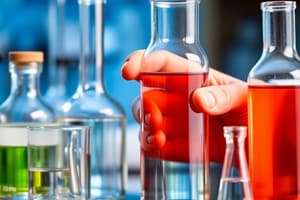Podcast
Questions and Answers
A scientist observes a substance with a definite volume but no definite shape. Which state of matter is the substance most likely in?
A scientist observes a substance with a definite volume but no definite shape. Which state of matter is the substance most likely in?
- Liquid (correct)
- Plasma
- Solid
- Gas
Which of the following is an example of a compound?
Which of the following is an example of a compound?
- Hydrogen (H2)
- Water (H2O) (correct)
- Oxygen (O2)
- Nitrogen (N2)
In an experiment, a student mixes sand and iron filings. Which of the following best describes the result?
In an experiment, a student mixes sand and iron filings. Which of the following best describes the result?
- Compound
- Solution
- Element
- Mixture (correct)
A solution has a pH of 3. Which of the following best describes the solution?
A solution has a pH of 3. Which of the following best describes the solution?
A car accelerates from rest to 20 m/s in 5 seconds. What is the car's acceleration?
A car accelerates from rest to 20 m/s in 5 seconds. What is the car's acceleration?
Which of Newton's laws best explains why you feel pushed back into your seat when a car rapidly accelerates?
Which of Newton's laws best explains why you feel pushed back into your seat when a car rapidly accelerates?
A student lifts a box weighing 10 N to a height of 2 meters. How much work is done?
A student lifts a box weighing 10 N to a height of 2 meters. How much work is done?
Which of the following is an example of a simple machine that uses a pivot point to multiply force?
Which of the following is an example of a simple machine that uses a pivot point to multiply force?
As the temperature of a gas increases, what happens to the average kinetic energy of its particles?
As the temperature of a gas increases, what happens to the average kinetic energy of its particles?
Sound waves travel faster in which of the following mediums?
Sound waves travel faster in which of the following mediums?
A researcher observes that plants grow taller when exposed to more sunlight. Which of the following is the MOST appropriate hypothesis?
A researcher observes that plants grow taller when exposed to more sunlight. Which of the following is the MOST appropriate hypothesis?
In an experiment testing the effect of a new fertilizer on plant growth, a scientist uses two groups of plants. Group A receives the fertilizer, while Group B does not. What describes Group B?
In an experiment testing the effect of a new fertilizer on plant growth, a scientist uses two groups of plants. Group A receives the fertilizer, while Group B does not. What describes Group B?
A student measures the length of a table three times and obtains the following measurements: 1.50 m, 1.51 m, and 1.49 m. What process is MOST important to improve the reliability and validity of the results?
A student measures the length of a table three times and obtains the following measurements: 1.50 m, 1.51 m, and 1.49 m. What process is MOST important to improve the reliability and validity of the results?
Which of the following correctly converts 5 kilometers into meters using the appropriate metric prefix?
Which of the following correctly converts 5 kilometers into meters using the appropriate metric prefix?
You need to accurately measure 25.5 mL of a liquid for an experiment. Which piece of equipment would be MOST appropriate?
You need to accurately measure 25.5 mL of a liquid for an experiment. Which piece of equipment would be MOST appropriate?
A rock has a mass of 150 grams and a volume of 50 cm3. What is the density of the rock?
A rock has a mass of 150 grams and a volume of 50 cm3. What is the density of the rock?
Which statement BEST describes the relationship between mass and weight?
Which statement BEST describes the relationship between mass and weight?
Which of the following BEST describes a solid state of matter?
Which of the following BEST describes a solid state of matter?
Flashcards
Scientific Method
Scientific Method
A systematic approach to conducting research, including observation, hypothesis, experimentation, data analysis, and conclusion.
Independent Variable
Independent Variable
The factor that is manipulated or changed by the researcher in an experiment.
Dependent Variable
Dependent Variable
The factor that is measured or observed in response to changes in the independent variable.
Controlled Variables
Controlled Variables
Signup and view all the flashcards
Replication in Experiments
Replication in Experiments
Signup and view all the flashcards
Measurement
Measurement
Signup and view all the flashcards
Mass
Mass
Signup and view all the flashcards
Density
Density
Signup and view all the flashcards
Liquid
Liquid
Signup and view all the flashcards
Element
Element
Signup and view all the flashcards
Atom
Atom
Signup and view all the flashcards
Acids
Acids
Signup and view all the flashcards
Displacement
Displacement
Signup and view all the flashcards
Velocity
Velocity
Signup and view all the flashcards
Force
Force
Signup and view all the flashcards
Newton's First Law (Inertia)
Newton's First Law (Inertia)
Signup and view all the flashcards
Energy
Energy
Signup and view all the flashcards
Heat
Heat
Signup and view all the flashcards
Study Notes
- Science encompasses a systematic and organized body of knowledge about the natural world and the processes used to acquire that knowledge.
- It involves observation, experimentation, and theoretical explanation to understand the universe and its phenomena.
Science Week 1: Scientific Method
- The scientific method comprises a systematic approach to conducting research.
- Key steps include:
- Observation: Identifying a problem or question through careful observation.
- Hypothesis: Developing a testable explanation or prediction based on observations.
- Experimentation: Designing and conducting experiments to test the hypothesis.
- Data Analysis: Analyzing the data collected during experiments.
- Conclusion: Interpreting the experimental results and drawing conclusions about the hypothesis.
- Variables in an experiment include:
- Independent variable: The factor that is manipulated or changed by the researcher.
- Dependent variable: The factor that is measured or observed in response to changes in the independent variable.
- Controlled variables: Factors that are kept constant during the experiment to ensure that only the independent variable affects the dependent variable.
- Control group: This group in an experiment does not receive the treatment, serving as a comparison baseline.
- Experimental group: The group in an experiment that undergoes the treatment being tested.
- Replication in experiments is vital, repeating the experiment multiple times ensures the reliability and validity of the results.
Science Week 2: Measurement and Units
- Measurement involves assigning numerical values to physical quantities.
- SI units (International System of Units) include:
- Length: meter (m)
- Mass: kilogram (kg)
- Time: second (s)
- Temperature: Kelvin (K)
- Amount of substance: mole (mol)
- Metric prefixes include:
- Kilo (k): 10^3
- Centi (c): 10^-2
- Milli (m): 10^-3
- Micro (µ): 10^-6
- Nano (n): 10^-9
- Volume measurement:
- Graduated cylinders, beakers, and pipettes are used to measure liquid volume.
- Volume can also be calculated for regular solids using mathematical formulas.
- Mass vs. weight:
- Mass is a measure of the amount of matter in an object.
- Weight is the force exerted on an object due to gravity.
- Density:
- Density is defined as mass per unit volume (ρ = m/V).
Science Week 3: Basic Chemistry
- Matter is anything that has mass and occupies space.
- States of matter:
- Solid: Has a definite shape and volume.
- Liquid: Has a definite volume but adapts to the shape of its container.
- Gas: Lacks a definite shape or volume.
- Plasma: An ionized gas with high temperature.
- Elements, compounds, and mixtures:
- Element: A pure substance consisting of only one type of atom.
- Compound: A substance formed by the chemical combination of two or more elements in a fixed ratio.
- Mixture: A combination of two or more substances that are physically combined.
- Atoms:
- The basic unit of matter, consisting of protons, neutrons, and electrons.
- Protons: Positively charged particles located in the nucleus.
- Neutrons: Neutral particles located in the nucleus.
- Electrons: Negatively charged particles orbiting the nucleus.
- Molecules:
- Formed when chemical bonds hold two or more atoms together.
- Chemical reactions:
- Processes that involve the rearrangement of atoms and molecules to form new substances.
- Acids, bases, and pH:
- Acids: Substances that donate protons (H+) or accept electrons, pH < 7.
- Bases: Substances that accept protons (H+) or donate electrons, pH > 7.
- pH: A measure of the acidity or alkalinity of a solution.
- Neutral pH: pH = 7.
Science Week 4: Basic Physics
- Motion:
- Displacement: Change in position.
- Velocity: Rate of change of displacement.
- Acceleration: Rate of change of velocity.
- Forces:
- A push or pull that alters an object's motion.
- Newton's laws of motion:
- 1st law (Inertia): An object at rest stays at rest, and an object in motion stays in motion with the same speed and direction unless acted upon by a force.
- 2nd law: Force equals mass times acceleration (F = ma).
- 3rd law: For every action, there is an equal and opposite reaction.
- Energy:
- The capacity to do work.
- Forms of energy: Kinetic, potential, thermal, electrical, chemical, nuclear.
- Work:
- Work occurs when a force causes displacement (W = Fd).
- Simple machines:
- Devices simplifying work by modifying the force's magnitude or direction.
- Examples: Lever, pulley, inclined plane, wheel and axle, wedge, screw.
- Heat and temperature:
- Heat: Transfer of thermal energy.
- Temperature: Measures the average kinetic energy of particles in a substance.
- Electricity and magnetism:
- Electric charge: Is a fundamental property of matter causing it to experience a force in an electromagnetic field.
- Electric current: Flow of electric charge.
- Magnetism: Force exerted by magnets.
- Waves
- A disturbance that transfers energy through matter or space.
- Types:
- Mechanical Waves: requires a medium
- Electromagnetic Waves: does not require a medium
- Sound
- Sound wave: a compression wave
- Speed of sound: depends on the medium
Quarter 1
- Scientific Method
- Measurement
- Matter
- Forces and Motion
Quarter 2
- Energy
- Waves
- Sound
- Light
Quarter 3
- Life Science
- Plant Reproduction
- Animal Reproduction
- Heredity
Quarter 4
- Earth Science
- Rocks and Minerals
- Plate Tectonics
- Earth's Atmosphere
Studying That Suits You
Use AI to generate personalized quizzes and flashcards to suit your learning preferences.




